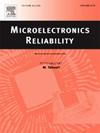探索在reram中使用极端温度来促进故障传播
IF 1.9
4区 工程技术
Q3 ENGINEERING, ELECTRICAL & ELECTRONIC
引用次数: 0
摘要
电阻式随机存取存储器(reram)是补充和/或取代几种新兴应用中采用的基于cmos的存储器的有希望的候选者。尽管reram具有各种优势——主要是CMOS工艺兼容性、零待机功耗、高可扩展性和密度——但在实际应用中使用reram取决于在制造后保证其质量。正如在基于CMOS的存储器中观察到的那样,reram也容易受到制造偏差的影响,包括缺陷和工艺变化,这可能导致与CMOS技术中观察到的错误行为不同,不仅增加了制造测试的复杂性,而且增加了执行测试所需的时间。在此背景下,本文提出研究利用温度促进reram中的故障传播,减少所需的测试时间。采用基于130 nm预测技术模型(PTM)库实现的3x3基于单词的ReRAM外围电路的案例研究。在所提出的研究中,在ReRAM单元的不同位置注入了17个缺陷,并考虑到三种不同的温度(25、100和-40°C),将其各自的故障行为分为常规故障和独特故障。结果表明,根据缺陷的位置,温度可以促进故障的传播,从而减少了进行制造测试所需的时间。本文章由计算机程序翻译,如有差异,请以英文原文为准。
Exploring the use of extreme temperatures to facilitate fault propagation in ReRAMs
Resistive Random-Access Memories (ReRAMs) represent a promising candidate to complement and/or replace CMOS-based memories adopted in several emerging applications. Despite all their advantages – mainly CMOS process compatibility, zero standby power, and high scalability and density – the use of ReRAMs in real applications depends on guaranteeing their quality after manufacturing. As observed in CMOS-based memories, ReRAMs are also susceptible to manufacturing deviations, including defects and process variations, that can cause faulty behaviors different from those observed in CMOS technology, increasing not only the manufacturing test complexity but also the time required to perform the test. In this context, this paper proposes to study the use of temperature to facilitate fault propagation in ReRAMs, reducing the required test time. A case study composed of a 3x3 word-based ReRAM with peripheral circuitry implemented based on a 130 nm Predictive Technology Model (PTM) library was adopted. During the proposed study, a total of 17 defects were injected in different positions of the ReRAM cell, and their respective faulty behavior was classified into conventional and unique faults, considering three different temperatures (25, 100, and -40 °C). The obtained results show that the temperature can, depending on the position of the defect, facilitate fault propagation, which reduces the time required for performing manufacturing testing.
求助全文
通过发布文献求助,成功后即可免费获取论文全文。
去求助
来源期刊

Microelectronics Reliability
工程技术-工程:电子与电气
CiteScore
3.30
自引率
12.50%
发文量
342
审稿时长
68 days
期刊介绍:
Microelectronics Reliability, is dedicated to disseminating the latest research results and related information on the reliability of microelectronic devices, circuits and systems, from materials, process and manufacturing, to design, testing and operation. The coverage of the journal includes the following topics: measurement, understanding and analysis; evaluation and prediction; modelling and simulation; methodologies and mitigation. Papers which combine reliability with other important areas of microelectronics engineering, such as design, fabrication, integration, testing, and field operation will also be welcome, and practical papers reporting case studies in the field and specific application domains are particularly encouraged.
Most accepted papers will be published as Research Papers, describing significant advances and completed work. Papers reviewing important developing topics of general interest may be accepted for publication as Review Papers. Urgent communications of a more preliminary nature and short reports on completed practical work of current interest may be considered for publication as Research Notes. All contributions are subject to peer review by leading experts in the field.
 求助内容:
求助内容: 应助结果提醒方式:
应助结果提醒方式:


